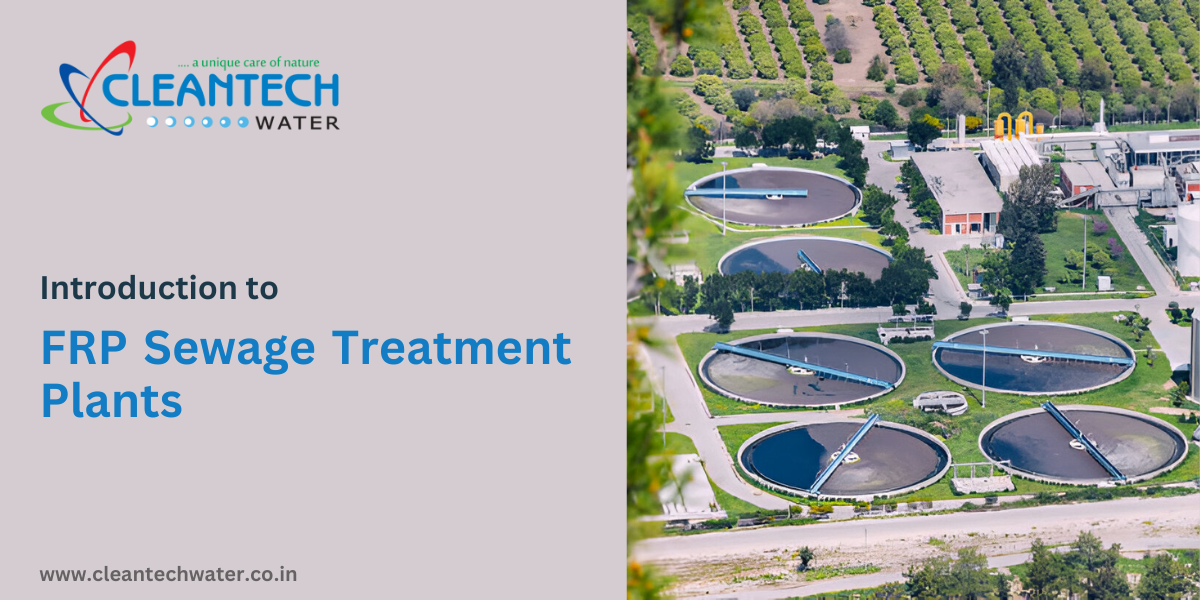In the quest for efficient and sustainable wastewater management, FRP (Fiber-Reinforced Plastic) sewage treatment plants have emerged as a cutting-edge solution. These systems are designed to address the growing challenges of sewage treatment with an emphasis on durability, efficiency, and environmental compliance. As urban areas expand and industrial activities increase, the need for robust and reliable sewage treatment systems becomes ever more critical.
FRP sewage treatment plants stand out due to their advanced materials and construction techniques. Unlike traditional concrete or steel-based systems, FRP plants leverage the unique properties of fibre-reinforced plastics to deliver superior performance. This guide explores how these plants work, their key components, and the advantages they offer in wastewater treatment.

Components of an FRP Sewage Treatment Plant
The efficiency and reliability of an FRP sewage treatment plant hinges on its carefully designed components. Here are the key elements that make up these systems:
- FRP Tanks and Vessels: The primary components are the FRP tanks and vessels used for various treatment stages. These are manufactured from fibre-reinforced plastic, providing resistance to corrosion and chemical attacks, which enhances the plant’s longevity.
- Pumps and Valves: Pumps and valves are essential for the efficient movement of sewage through the treatment stages. These plants use high-quality, corrosion-resistant pumps and valves to ensure smooth operation.
- Aeration Systems: For biological treatment, aeration systems are used to supply oxygen to microorganisms. These systems are designed to optimise oxygen transfer and support the biological treatment processes.
- Control Panels: Modern FRP plants are equipped with control panels that automate various processes and monitor performance. These panels ensure efficient operation and allow for real-time adjustments based on operational conditions.
- Filtration Units: Advanced filtration units are employed in the tertiary treatment stage to remove remaining impurities from the treated water. These units are designed to provide high filtration efficiency and meet stringent discharge standards.
How Do FRP Integrated Sewage Treatment Plants Work?
FRP sewage treatment plants are designed to efficiently treat and manage wastewater through a series of well-coordinated processes. These plants integrate several stages including:
- Pre-Treatment: The first step involves screening and sedimentation to remove large solids and debris from the incoming sewage. This is crucial for protecting downstream equipment and ensuring the smooth operation of the treatment process.
- Primary Treatment: During primary treatment, the sewage is subjected to settling tanks where suspended solids are allowed to settle out. This step helps in reducing the load on secondary treatment processes.
- Secondary Treatment: This stage involves biological treatment methods, such as activated sludge processes or trickling filters, to further degrade organic matter. Microorganisms play a key role in breaking down pollutants and improving the quality of the effluent.
- Tertiary Treatment: For advanced treatment, tertiary processes may be employed, including filtration and disinfection. This stage ensures the treated water meets the required quality standards before being discharged or reused.
- Sludge Management: The treatment process generates sludge, which needs proper handling. FRP plants include mechanisms for sludge thickening, dewatering, and disposal, ensuring effective management of by-products.
Why Are FRP Sewage Treatment Plants Important?
- Superior Corrosion and Chemical Resistance: Unlike traditional materials like concrete and steel, FRP is highly resistant to corrosion and chemical damage. This ensures a longer operational life and reduces the risk of structural failures, even in harsh wastewater conditions.
- Compact and Modular Design: FRP sewage treatment plants feature a lightweight and modular construction, allowing for easier installation in constrained spaces. This is particularly advantageous in urban areas with limited land availability.
- Scalability and Flexibility: The modular nature of FRP plants enables scalability, allowing for adjustments based on varying wastewater volumes and treatment needs. This flexibility ensures the plant can grow with changing demands.
- Environmental Sustainability: By efficiently treating wastewater, FRP plants help reduce pollution and protect natural water bodies. The treated water can be safely discharged or reused, supporting water conservation efforts and promoting sustainable practices.
Cost and Maintenance Benefits Of FRP Sewage Treatment Plants
Cost-Effectiveness
One of the key advantages of FRP sewage treatment plants is their cost-effectiveness. Although the initial investment may be higher compared to traditional systems, the long-term savings are significant. The primary reasons for this include:
- Durability: FRP materials are highly resistant to corrosion, reducing the need for frequent repairs and replacements. This longevity translates to lower lifecycle costs and minimised downtime.
- Reduced Installation Costs: The lightweight and modular nature of FRP components simplifies transportation and installation. This can lead to reduced labour and installation costs compared to heavier, conventional materials.
- Energy Efficiency: FRP plants often feature advanced design elements that enhance energy efficiency. Improved aeration systems and optimised processes contribute to lower energy consumption, resulting in reduced operational costs.
Maintenance Benefits
FRP sewage treatment plants are designed with maintenance in mind, offering several advantages in this area:
- Minimal Corrosion Issues: Unlike traditional materials, FRP is not susceptible to corrosion from wastewater or environmental factors. This reduces the need for regular inspections and maintenance related to corrosion damage.
- Ease of Cleaning: The smooth surface of FRP components facilitates easier cleaning and maintenance. This helps prevent the buildup of sludge and other contaminants, ensuring consistent performance and extending the lifespan of the plant.
- Long-Term Reliability: The durability and resistance of FRP materials contribute to the overall reliability of the plant. Fewer breakdowns and maintenance issues lead to uninterrupted operation and reduced maintenance costs over time.
- Simplified Repairs: In the rare event that repairs are needed, FRP components are often easier to fix or replace compared to traditional materials. This can lead to quicker turnaround times and less disruption to plant operations.
Applications of FRP Sewage Treatment Plants
FRP sewage treatment plants are versatile solutions designed to address a wide range of wastewater management needs. Their adaptability and efficiency make them suitable for various applications, from residential communities to industrial facilities. Understanding the diverse applications helps stakeholders appreciate their value and potential benefits in different contexts.
Residential and Commercial Developments
In residential and commercial developments, FRP plants are increasingly popular due to their compact design and durability. Urban areas, where space is often limited, benefit from the modular and space-saving features of FRP systems. These plants can be installed in confined spaces such as apartment complexes, shopping malls, and office buildings, providing efficient sewage treatment without compromising on space. The lightweight nature of FRP components simplifies the installation process in urban settings, reducing the need for extensive excavation and structural modifications.
Industrial Facilities
Industrial facilities generate wastewater with varying levels of contaminants, including chemicals and heavy metals. FRP-integrated STPs are well-suited for treating such complex wastewater due to their robust construction and chemical resistance. Industries such as manufacturing, textiles, and pharmaceuticals can benefit from FRP systems that handle high-strength effluents and comply with stringent discharge regulations.
Municipal Sewage Treatment
Municipalities responsible for managing large volumes of sewage from urban and suburban areas can leverage FRP sewage treatment plants to improve their infrastructure. FRP systems offer scalability, allowing municipalities to expand their treatment capacities as population and wastewater volumes grow. The modular design facilitates phased implementation, making it easier to upgrade or expand treatment facilities as needed.
Contact Us for Customised Sewage Treatment Plant Solutions at Affordable Prices!
The Uses of FRP in Sewage Treatment
Scrubber Vessels:
Purpose: Scrubber vessels are used to remove pollutants from exhaust gases and wastewater streams.
FRP Advantage: FRP’s resistance to corrosion and chemical damage makes it ideal for constructing these vessels, ensuring durability and long-term performance in aggressive environments.
Pipes:
Purpose: Pipes transport wastewater through various stages of treatment.
FRP Advantage: FRP pipes are lightweight yet strong, reducing installation complexity and handling costs. Their resistance to chemical attacks extends their lifespan and reliability in handling diverse wastewater compositions.
Ductwork:
Purpose: Ductwork channels air and gases throughout the treatment plant.
FRP Advantage: The corrosion-resistant properties of FRP ensure ductwork remains intact and functional even when exposed to corrosive or abrasive substances, improving overall system efficiency.
Fans:
Purpose: Fans are used for ventilation and air circulation within treatment facilities.
FRP Advantage: FRP fans are resistant to chemical degradation and high temperatures, enhancing their performance and reliability in demanding operational conditions.
Stacks:
Purpose: Stacks release treated gases and vapours into the atmosphere.
FRP Advantage: FRP stacks are durable and resistant to environmental factors such as acid rain and pollutants, ensuring safe and effective emission control.
Chemical Feed Systems:
Purpose: Chemical feed systems add necessary chemicals to the wastewater to aid in treatment processes.
FRP Advantage: The chemical resistance of FRP makes it ideal for housing chemical feed systems, preventing damage from aggressive chemicals and ensuring continuous operation.
Removal of Pollutants in FRP-Integrated STPs
Effective pollutant removal is a critical aspect of any sewage treatment plant, and FRP-integrated systems are designed to excel in this area. These plants incorporate advanced treatment technologies to ensure the comprehensive removal of various pollutants, resulting in high-quality effluent that meets environmental standards.
Physical Pollutant Removal
The first stage of pollutant removal in FRP sewage treatment plants involves physical processes such as screening and sedimentation. Screening removes large debris and solids from the incoming sewage, while sedimentation allows suspended particles to settle out. These preliminary steps prevent clogging and damage to downstream equipment, preparing the wastewater for further treatment.
Biological Pollutant Removal
Biological treatment processes are central to the removal of organic pollutants in FRP plants. Methods such as activated sludge processes, trickling filters, and moving bed biofilm reactors (MBBRs) utilise microorganisms to break down organic matter. The microorganisms consume organic pollutants, converting them into simpler compounds and reducing the biochemical oxygen demand (BOD) of the wastewater.
Chemical Pollutant Removal
For wastewater containing chemical pollutants, FRP sewage treatment plants employ advanced chemical treatment methods. These may include chemical precipitation, where chemicals are added to form insoluble compounds that are then removed by sedimentation. Additionally, oxidation processes, such as ozonation or advanced oxidation processes (AOPs), can be used to degrade hazardous chemicals and ensure the treated water is safe for discharge or reuse.
Tertiary Treatment
To achieve the highest level of effluent quality, FRP plants may include tertiary treatment stages. This final stage involves additional filtration and disinfection processes to remove any remaining contaminants. Techniques such as membrane filtration, activated carbon adsorption, and UV disinfection ensure the treated water meets stringent discharge standards and is suitable for various reuse applications.
Commonly Asked Questions
1. What types of wastewater can FRP sewage treatment plants handle?
FRP sewage treatment plants are designed to handle a variety of wastewater types, including domestic sewage, industrial effluents, and commercial waste. Their chemical resistance and customisable features allow them to treat wastewater with different levels of contaminants effectively.
2. How long do FRP plants typically last?
FRP sewage treatment plants are known for their durability and can last 20-30 years or more with proper maintenance. The fibre-reinforced plastic used in their construction resists corrosion and environmental damage, contributing to their extended lifespan.
3. Are FRP sewage plants suitable for small-scale applications?
Yes, FRP sewage treatment plants are highly versatile and suitable for small-scale and large-scale applications. Their modular design allows for easy installation in residential, commercial, and industrial settings, accommodating various wastewater treatment needs.
4. What maintenance is required for an FRP plant?
Maintenance for FRP sewage treatment plants is relatively minimal compared to traditional systems. Routine tasks include checking and cleaning filters, monitoring pump and aeration systems, and inspecting for any signs of wear or damage. Regular maintenance ensures optimal performance and longevity.
5. Can FRP plants be retrofitted into existing systems?
Yes, FRP sewage treatment plants can be integrated into existing wastewater treatment systems. Their modular and flexible design allows for retrofitting, enabling upgrades to enhance capacity and efficiency without major modifications to existing infrastructure.
Upgrade to a Cutting-Edge FRP Sewage Treatment Plant Today!
Cleantech Water offers advanced FRP systems with unmatched durability, efficiency, and low maintenance, ensuring your wastewater treatment needs are met with precision and reliability. Whether for residential, commercial, or industrial applications, our FRP sewage treatment plants are designed to handle diverse wastewater challenges with ease.
Invest in a solution that stands the test of time and reduces operational costs. Contact us at +91-9099915539 or +91-9558996411 to learn how our wastewater treatment plant solutions can enhance your facility’s performance and sustainability.

